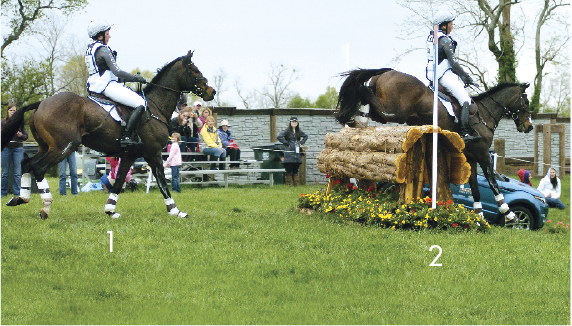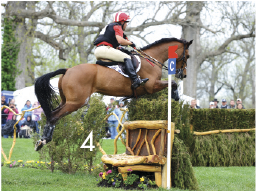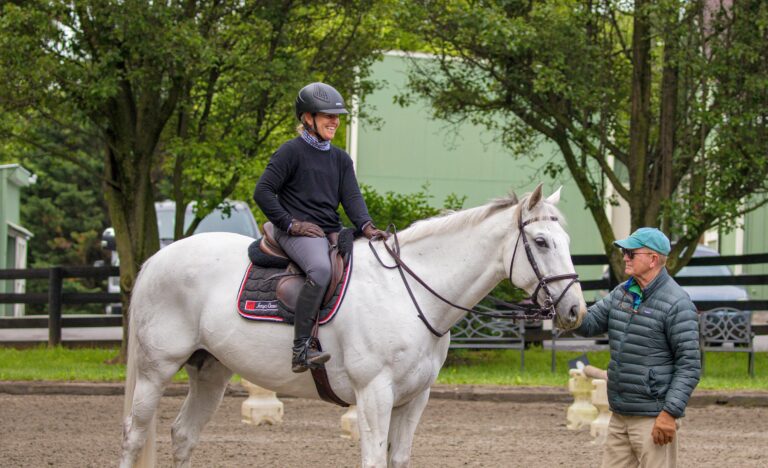
The Rolex Kentucky Three-Day Event is on every horseperson’s bucket list, and this was a good year to check it off because when the stars align as they did for the 2013 competition, you can be sure of one of the most thrilling spectacles in all of sports.
One reason you feel such anticipation is that you know you will see the world”s best riders competing at the world”s best venue. Rolex, the event, and Rolex, the sponsor, have a partnership reaching back nearly 35 years, which is unheard of in sports marketing. The resulting event shows expert touches everywhere you look. The Kentucky Horse Park has developed facilities that are unmatched, from commodious stabling to space-age arena footing. The signage, the trade fair, every single detail says “world-class event.” All we have to do is sit back and enjoy the show and what a show it was this year, with several contenders at the top of their game competing for substantial prize money, a Rolex watch and the prestige of winning a four-star event. The money and the prizes are impressive, but in the final analysis, it is not what you win, it”s who you beat to win it?and on that basis, 2013 winner New Zealand”s Andrew Nicholson can be content with his efforts on Deborah Sellar”s Quimbo.
Like all good competitions, Rolex did not seem to be a foregone conclusion at the start. If anything, it seemed more likely that Andrew”s chief rival, Great Britain”s William Fox-Pitt, would be the winner. William was riding a more experienced horse, and the KHP has always been a friendly course for him. (He’s won Rolex twice, most recently in 2012.) But that’s why they hold the Kentucky Derby (to see who wins) and that’s why more than 50,000 people show up each year on the last weekend in April to see who wins “The Rolex.”
From the first horse to canter down the centerline of the dressage arena, the best riders in the world showed why they are the best, as each polished round ?improved on the last. Most of the numerous four-star rookies who showed up exited the ring chagrined but enlightened.
Regardless of their dressage scores, all the riders agreed that this year’s Rolex would not be a dressage competition. The cross-country course designer here, Derek di Grazia, is notorious for building courses that are harder than they walk?and he was up to his usual standard again this year. A casual glance at the number of “double clears” (rounds with no jumping or time faults) would give you the impression that the 2013 course was easy. The simple answer, however, is that the course was not easy. The best riders in the world just made it look easy. The rest of the riders, not so much. It is hard to explain about four-star competitions to riders until they find it out for themselves. The photos we”ll analyze in this column are proof of the adage that experience is what you get right after you needed it.
It is, of course, a three-phase event, so for success at Rolex you also have to have what I call “Sunday-afternoon nerve.” My point is that on Sunday morning, all the riders can easily clear the fences of Richard Jeffery”s stadium course because nobody is nervous. But not many of them can do it on Sunday afternoon, on prime-time national television, with a chance at the title, the Rolex watch and substantial prize money. All it takes is a fabulous horse, heaping amounts of talent, years of experience and nerves of steel. Fortunately for Andrew, who also finished third with Calico Joe, he has those qualities in abundance. In addition, this year he has a new Rolex watch to go with it.
The heart of any event is the cross country, and the photos in this article show you just how skilled the best of the best were at Rolex 2013.
Go to page 2 to read Jim”s comments on Andrew Nicholson and Quimbo.
Andrew Nicholson & Quimbo

1. Andrew Nicholson and Quimbo were great examples of how to jump 13ABCD, the Sunken Road. When Rolex course designer Derek di Grazia uses most of the alphabet to number a combination, it means a four-star problem. Any one of the four jumping efforts would be more than most of us would want to jump. When you have to jump them in sequence, the difficulty is significant. A great cross-country rider, Andrew is in exactly the right place in this final stride. His lower leg is secure, he has a straight line from his elbow to his horse”s mouth, his back is flat and his eyes are focused on the top rail of 13A. I especially like Andrew”s light seat here, which allows “Buddy” the free use of his back to prepare his jumping motion.
2. A balanced approach produces a balanced jump. Andrew”s lower leg is back slightly, telling Buddy to keep coming forward. Buddy is measuring his landing; meanwhile, Andrew is obviously leaving the bounce and drop to Buddy and looking at the bank. I especially like the fact that Andrew has not yet started to slip his reins. The correct instant to slip your reins is when your horse”s neck starts forward and down, which you will see shortly.
3. In a funny sort of way, Andrew is giving a dressage display here his horse is balanced and poised in front of his legs and seeking both sides of the contact equally. Buddy, landing in balance, is already planning his step down into the Sunken Road. Andrew”s very correct lower leg is the reason he is so perfectly placed: His eyes are still on the bank ahead, and his touch on the reins is light as a feather. Because he rides with his stirrups appropriately adjusted for upper-level cross country (with a 65- or 70-degree angle behind his knee when seated in the saddle), Andrew can land just above the saddle. Because Buddy”s back is unencumbered, he is relaxed and free with his hindquarters over a fence that many horses bumped behind on Saturday. Because Buddy”s head and neck are still up, Andrew”s reins are still the same length.
4. Buddy”s relaxed head and neck enable him to look down into the Sunken Road. Realizing the bank is not as big as it looked a split second ago, he is stepping down, rather than making the mistake of jumping out into the two-stride distance ahead of him. Andrew, still looking at the bank at 13C, is slipping the reins slightly, allowing Buddy the full use of his head and neck.
5. Andrew knows there are two big efforts left to jump, and his lower leg slips back slightly as he communicates this to Buddy. His upper body is in the right place, with his leg closed but his shoulders in front of his hips. His ?elbows have opened up, allowing Buddy to go forward to the bank.
6. Buddy is obviously measuring his effort over the bounce and brush at 13D. Because Andrew”s lower leg slipped back before the bank, he is seated on the saddle, rather than just above. I like to see riders more with their horses at this instant, with a sliver of air between their seat and the saddle.
7. Fortunately for Andrew, his horse has not read my books. Buddy ignores me and delivers a fantastic leap out of the sunken road. Andrew is behind the motion, but he was not left behind, and his elbows make sure Buddy can use his neck as his “fifth leg.” Andrew is wasting no time and is already planning his turn to the right for a quick getaway.
Go to page 3 to read Jim”s comments on Lynn Symansky and Donner.Lynn Symansky & Donner

1. The Horse Park Barns, 26AB, came very late in the course of 28 obstacles, and competitors” strategies varied widely. Legendary football coach Vince Lombardi once remarked, “Fatigue makes cowards of us all.” Riders whose horses were tired cantered sensibly over the two barns, jumping safely rather than risking serious trouble. Then along came Lynn Symansky and Donner. Statistically, successful four-star horses are about 75 percent Thoroughbred. Given that Donner is all Thoroughbred, Lynn had a real advantage and she made the most of it. In the first image, she and Donner are jumping from the perfect distance and taking a fabulous shape in the air. With technique like that, Donner could easily win a hunter derby. I would like to see Lynn closer to the saddle, but she is going with her horse and going for the optimum time.
2. Donner lands well and is reaching for new territory, the sign of a fit horse. Lynn is where she should be, with her weight above Donner”s back and sinking in her ankles, and her reins adjusted. Both of them already have the next fence in their sights.
3. You could come through this combination quietly or aggressively but not indecisively. Donner loves a forward ride, and with Lynn”s weight off of his back he can swing his hindquarters well under his body. His shoulders are up in front of his body, and we can see he is in superb balance, even though he is traveling about 20 miles an hour at this point. From here, he will take one more stride and let himself go into the air.
4. These two are not messing around. Donner left about 10 feet away from a maximum barn (3-foot-11 high, 9-foot-2 base spread), and makes it look easy. Again, Lynn is too high above the saddle to suit me, but with a horse as brave and fit as Donner, you can afford to ride in front of the motion. Lynn was fifth this year with a broken hand and pulled back muscles. If we can get her as fit and well as Donner next year, the European riders will have to pick up their game a little to stay with her.
Go to page 4 to read Jim”s comments on Meghan O”Donoghue and Pirate.Meghan O”Donoghue & Pirate

1. One of the best things about any Rolex is watching new riders step onto the four-star stage and sparkle. And what a star Meghan O”Donoghue proved to be, along with her lovely Thoroughbred partner, Pirate. As the highest-placed rookie combination this year, finishing 12th, they are poised to be stars for a long time.
In the final stride before The Land Rover Hollow at 17ABC, Meghan is riding with her stirrups correctly adjusted for big cross-country fences. She has, however, made a typical mistake of younger riders in supporting her horse by leaning back with her body rather than by closing her elbows. When she watches Andrew Nicholson”s videos, she will see what I mean. I rarely want riders” shoulders behind their hips when approaching obstacles on level ground. This tends to hollow the horse”s back and elevate his neck too high. Meghan”s martingale is one hole too short, which explains the subtle break in the straight line from her elbow to Pirate’s mouth. Pirate knows he is going to stand off a little too far from 17A, but he is not at all worried and is planning his takeoff.
2. Meghan knows that Pirate has overjumped 17A, and she has put her stirrup leather in front of the vertical to protect her upper body against the shock of landing. I like the length of her reins here she has slipped them, but not let them go completely loose, which enables her to handle a complex combination. Meghan”s strong lower leg ?allows her to land in balance and prepare her turn to the right. Look at Pirate”s expression: If you drew a cartoon bubble over his head, the caption would read, “Oh goodie, more jumps!”

3. This angle shows you how steep the drop was behind 17A, and how sharp the turn is to 17B. Meghan obviously has things under control and is working to maintain her balance and alignment. Pirate is focused on the next fence and is about to take his final strides. As usual, a strong lower-leg position gives Meghan the stable platform she needs to apply the right aids at the right time.
4. Both Pirate and Meghan see their stride and are preparing their takeoff. Meghan is a bit too upright to suit me. I prefer for riders to be closer to the saddle; the closer you are to your saddle, the more harmonious you can be with your horse. Standing almost upright, you are in danger of balancing yourself on your horse”s mouth, which could cause him to invert.

5. Look at the engagement of Pirate”s hindquarters. He sees that 17B is a spread, and he is preparing a little extra effort. Although Meghan”s lower leg has slipped back a bit due to her closing her heels, she is in the right place at the right time. She is keeping her legs on at the girth and her horse is straight between her reins (even though they are jumping a 3-foot-11 cabin on a 45-degree angle). Perhaps most importantly, Meghan is still touching the saddle with her seat and waiting for Pirate to leave the ground before she bends over. If we make a mistake cross country, we need to be slightly behind the motion, not in front of it.
6. If you want to ride well cross country, you need a strong lower leg. Meghan shows a classic leg position here, although from this angle I think she might take some of her prize money and get a saddle made to fit her. She is quite long-legged, and I noticed in several photos (I looked at more than 6,000 photos this year) that her seat was occasionally behind the cantle, usually the sign of a saddle that is too short for the rider. It is obvious that Meghan and Pirate are already looking for the last jump in this combination. They are going to land absolutely straight and gallop up the steep slope to 17C, another 3-foot-11 cabin. Meghan and Pirate are the picture of composure here, and you can see why they were so successful. We will see more of this pair in the future.
Go to Page 5 to read Jim”s comments on Buck Davidson and Ballynoe Castle RM.
Buck Davidson & Ballynoe Castle RM

1. Finishing fourth, Buck Davidson and Ballynoe Castle RM (Reggie) were the best-placed U.S. combination this year. They had one of the best rounds of the day certainly the most determined. The HSBC Water Park, Fence 7ABC, was the first water on the course and a serious question. The rails that Buck and Reggie are landing over in the first photo are 3-foot-7 and at the top of a mound, which makes them appear even larger as the horse and rider gallop up to them. It takes a brave horse and rider to jump them as well as Buck and Reggie. You can tell they are both looking ahead to the next jump.
2. Buck has his eyes focused on the top of the carved rainbow trout at 7B. This jump is 3-foot-9 and extremely narrow, but Reggie is nicely balanced and obviously has things under control. Buck knows his horse is a great jumper, but time is a factor and he must not waste precious seconds getting everything perfectly organized between fences. The bow wave Reggie is making tells you about the speed of this pair. The photo does not show how steep the drop was behind 7A or how tight the turn was down the slope to 7B.
3. Reggie is taking care of business at 7B while Buck is already planning his turn and approach to the enormous brush at 7C. While riders have the ?option of being bold and aggressive or slow and careful, bold is Buck”s middle name. Reggie is in no doubt about what is going to happen next. Buck’s right leg is pressing him to the left, and the open left rein is giving him the correct direction. Buck will land exactly where I want riders to land, poised above the withers with short, soft reins.

4. Reggie responds to Buck’s aggressive riding with a prodigious leap. I’d like to see Buck a little farther over his horse’s withers, but the overall ride is so strong and confident that it is hard to be critical. And speaking of critical, every year at Rolex, I successfully conceal my admiration for Buck, who also finished this year in ninth place with Mar De Amor and 22nd place with Park Trader. Several years ago, he made the mistake of admitting that my pre-Rolex remarks got under his skin. He compounded his mistake by claiming that he rode better when he was mad. Well, ever since then, I have made it my mission to make sure that Buck rides well at Rolex. I can hardly wait until Rolex 2014. You will be able to tell Buck is coming he”ll be the one with steam rising from under his helmet.
This article originally appeared in the July 2013 issue of Practical Horseman magazine.










